初二英语下册第一单元讲义讲解学习
- 格式:doc
- 大小:36.00 KB
- 文档页数:5

Unit 1 What’s the matter? 知识点总结一、基本知识点1. What’s the matter (with you)? 怎么了?出什么事了?matter的用法(1)名词:事情,问题 What’s the matter? =what’s wrong (with you)? =what’s the trouble 怎么啦?出什么事啦?(2)动词:有重大影响,有重要性如:What does it matter?-What’s the trouble/ the problem / wrong with sb./ sth.?-I had a cold.我感冒了。
have a cold=catch a cold=have the flu have a feverhave a cough咳嗽have a stomachache胃疼,肚子疼have a toothache牙疼have a headache头疼2. 身体部位+ache(疼痛)构成新的复合词stomach+ache=stomachache head+ache=headache tooth+ache=toothache back+ache=backache3.should的用法:1)用于第一人称疑问句,表征询意见。
如:Should I open the window? 我可以开窗户吗?2)should表义务或提建议,可用于各种句式,通常指将来。
如:You should do what your parents tell you. 你应该照你父母的话去做事。
He should do some work, but he doesn’t want to. 他应该做些工作,但是他不想做。
也可指现在。
如:You shouldn’t feel so unhappy over such trifles.对这种小事,你不应该感到这么不高兴。
You shouldn’t be sitting in the sun. 你不应该坐在阳光下。
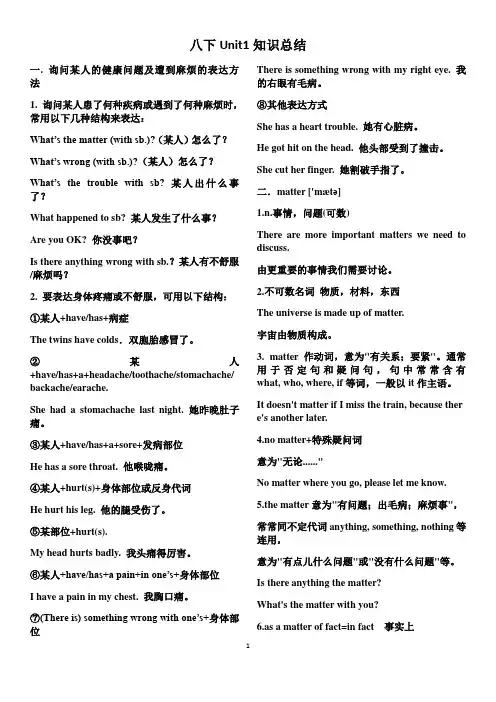
一. 询问某人的健康问题及遭到麻烦的表达方法1. 询问某人患了何种疾病或遇到了何种麻烦时,常用以下几种结构来表达:What’s the matter (with sb.)?(某人)怎么了?What’s wrong (with sb.)?(某人)怎么了?What’s the trouble with sb? 某人出什么事了?What happened to sb? 某人发生了什么事?Are you OK? 你没事吧?Is there anything wrong with sb.?某人有不舒服/麻烦吗?2. 要表达身体疼痛或不舒服,可用以下结构:①某人+have/has+病症The twins have colds.双胞胎感冒了。
②某人+have/has+a+headache/toothache/stomachache/ backache/earache.She had a stomachache last night. 她昨晚肚子痛。
③某人+have/has+a+sore+发病部位He has a sore throat. 他喉咙痛。
④某人+hurt(s)+身体部位或反身代词He hurt his leg. 他的腿受伤了。
⑤某部位+hurt(s).My head hurts badly. 我头痛得厉害。
⑥某人+have/has+a pain+in one’s+身体部位I have a pain in my chest. 我胸口痛。
⑦(There is) something wrong with one’s+身体部位There is something wrong with my right eye. 我的右眼有毛病。
⑧其他表达方式She has a heart trouble. 她有心脏病。
He got hit on the head. 他头部受到了撞击。
She cut her finger. 她割破手指了。
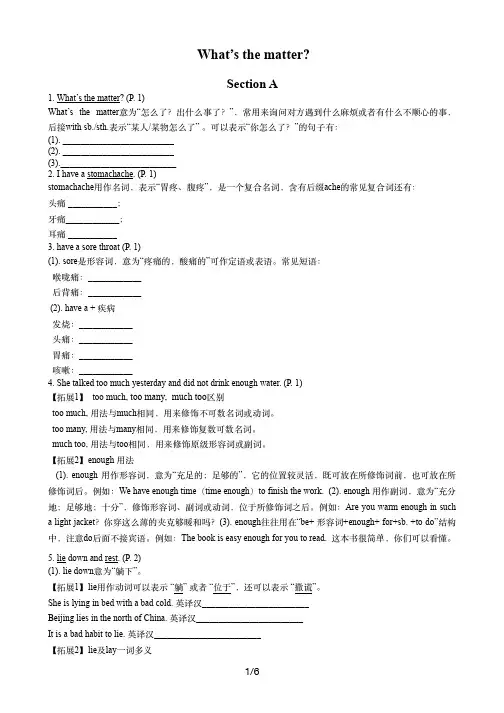
What’s the matter?Section A1. What’s the matter? (P. 1)What’s the matter意为“怎么了?出什么事了?”,常⽤来询问对⽅遇到什么⿇烦或者有什么不顺⼼的事,后接with sb./sth.表⽰“某⼈/某物怎么了” 。
可以表⽰“你怎么了?”的句⼦有:(1). _________________________(2). _________________________(3).__________________________2. I have a stomachache. (P. 1)stomachache⽤作名词,表⽰“胃疼、腹疼”,是⼀个复合名词,含有后缀ache的常见复合词还有:头痛 ___________;⽛痛____________;⽿痛 ___________3. have a sore throat (P. 1)(1). sore是形容词,意为“疼痛的,酸痛的”可作定语或表语。
常见短语:喉咙痛:____________后背痛:____________(2). have a + 疾病发烧:____________头痛:____________胃痛:____________咳嗽:____________4. She talked too much yesterday and did not drink enough water. (P. 1)【拓展1】 too much, too many, much too区别too much, ⽤法与much相同,⽤来修饰不可数名词或动词。
too many, ⽤法与many相同,⽤来修饰复数可数名词。
much too, ⽤法与too相同,⽤来修饰原级形容词或副词。
【拓展2】enough ⽤法(1). enough ⽤作形容词,意为“充⾜的;⾜够的”,它的位置较灵活,既可放在所修饰词前,也可放在所修饰词后。
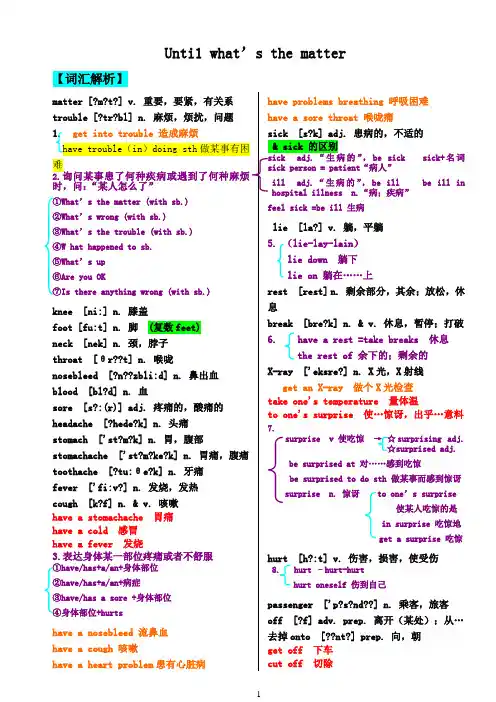
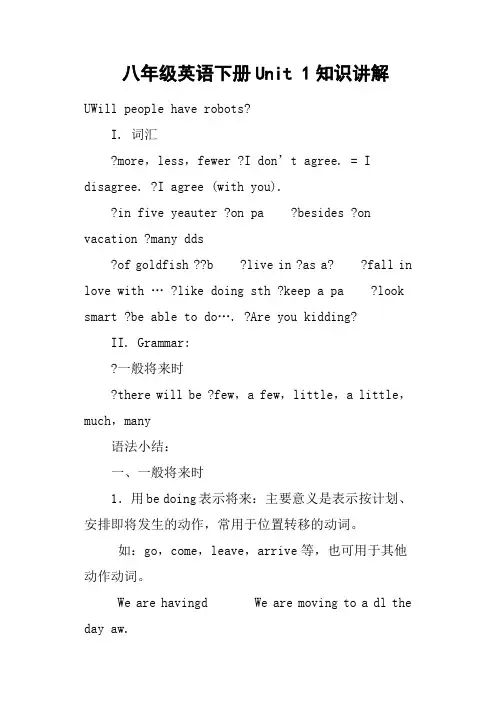
八年级英语下册Unit 1知识讲解UWill people have robots?I. 词汇?more,less,fewer ?I don’t agree. = I disagree. ?I agree (with you).?in five yeauter ?on pa ?besides ?on vacation ?many dds?of goldfish ??b ?live in ?as a? ?fall in love with … ?like doing sth ?keep a pa?look smart ?be able to do…. ?Are you kidding?II. Grammar:?一般将来时?there will be ?few,a few,little,a little,much,many语法小结:一、一般将来时1.用be doing表示将来:主要意义是表示按计划、安排即将发生的动作,常用于位置转移的动词。
如:go,come,leave,arrive等,也可用于其他动作动词。
We are havingd We are moving to a dl the day aw.这种用法通常带有表示将来的时间状语,如果不带时间状语,则根据上下文可表示最近即将发生的动作。
A: Where are you going? B: I am going for a walk. Are you coming with me?A: Yes,I am jug. Wa 2.用be going to do 表示将来:主要意义,一是表示“意图”,即打算在最近的将来或将来进行某事。
Are you goingat letter?How long is he going to stay here?I am going to book a 另一意义是表示“预见”,即现在已有迹象表明将要发生或即将发生某种情况。
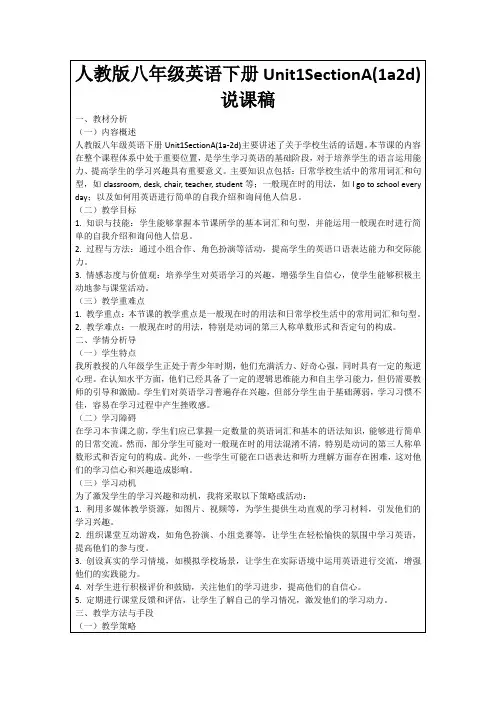
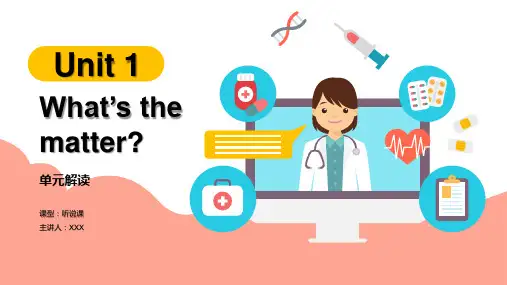
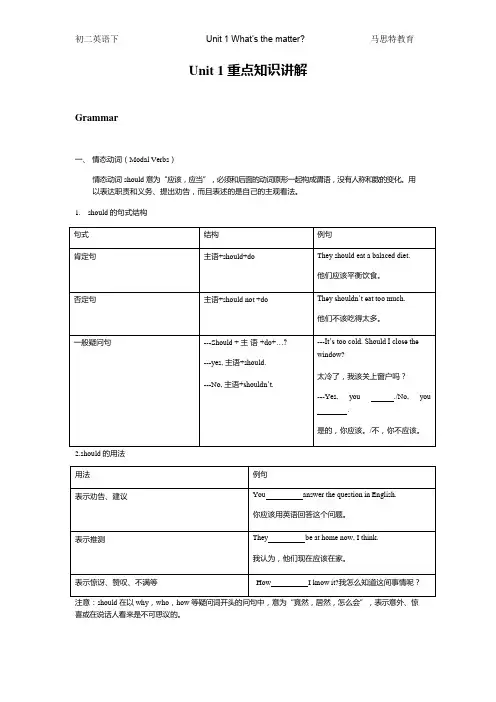
Unit 1 重点知识讲解Grammar一、情态动词(Modal Verbs)情态动词should 意为“应该,应当”,必须和后面的动词原形一起构成谓语,没有人称和数的变化。
用以表达职责和义务、提出劝告,而且表述的是自己的主观看法。
1.should 的句式结构2.s hould 的用法喜或在说话人看来是不可思议的。
二、其他表示建议的句型表示反射或强调的代词叫做反身代词。
反身代词是由第一人称、第二人称形容词性物主代词或第三人称代词的宾格形式,词尾加self 或selves 组成。
反身代词可译“本人”、“本身”,为加强语气,也常翻译为“亲自”、“自己”。
不定人称代词one ---- oneself.1、反身代词的分类2、反身代词的用法单词的用法Section A1.What’s the matter?怎么了?该句常用询问某人患了何种疾病或遇到了什么麻烦,其后用with 引出对象。
1). What’s the matter with sb.?=what’s wrong with sb.?=what’s the trouble/problem with sb.?=what’s one’s trouble/problem?e.g. What’s the matter with Tom?=what’s with Tom?=What’s the with Tom?=What’s Tom’s?2). matter, 名词,“问题,事情”e.g. We have important (matter) to discuss.我们有些重要的问题要讨论。
3). 动词,“要紧,关系重大”e.g. It dosen’t that you came late.2.I have a cold.我感冒了。
1).have/get/catch a cold “感冒,着凉”The old man a cold yesterday.那位老人昨天感冒了。

八年级英语下册Unit 1知识讲解Unit1illpeplehaverbts?I辞汇?re,less,feer?Idn’tagree=Idisagree?Iagree?infiveearsnputer?npaper?besides?nvaatin?andifferentinds?fgldfish?nre?befree?livein?asareprter?freetie?fallinlveith…?liedingsth?eepaparrt?lsart?beabletd…?Areuidding?IIGraar:?一样以后时?thereillbe?fe,afe,little,alittle,uh,an语法小结:一、一样以后时1.用beding表示以后:要紧意义是表示按打算、安排即将发生的动作,经常使用于位置转移的动词。
如:g,e,leave,arrive等,也可用于其他动作动词。
earehavingfishfrdinnerearevingtadifferenthtelthedaaftertrr这种用法通常带有表示以后的时刻状语,若是不带时刻状语,那么依照上下文可表示最近即将发生的动作。
A:hereareuging?B:IagingfraalAreuingithe?A:es,Iaustingaitfre2.用begingtd表示以后:要紧意义,一是表示“用意”,即打算在最近的以后或以后进行某事。
Areugingtpstthatletter?Hlngishegingtstahere?Iagingtbatiet另一意义是表示“预见”,即此刻已有迹象说明将要发生或即将发生某种情形。
It’sgingtrainGergeisputtingneight;heisgingtbequitefat3用ill/shalld表示以后:要紧意义,一是表示预见。
uillfeelbetteraftertaingthisediineDuthinitillrain?二是表示用意IillntlendthebtuTaeiteas,Iillntditanlnger大体结构:Sheillethavelasstrrillsheethavelasstrr?Shen’tethavelasstrrhatillshedtrr?二、Therebe结构1there be 结构中的be是能够运用各类时态的。
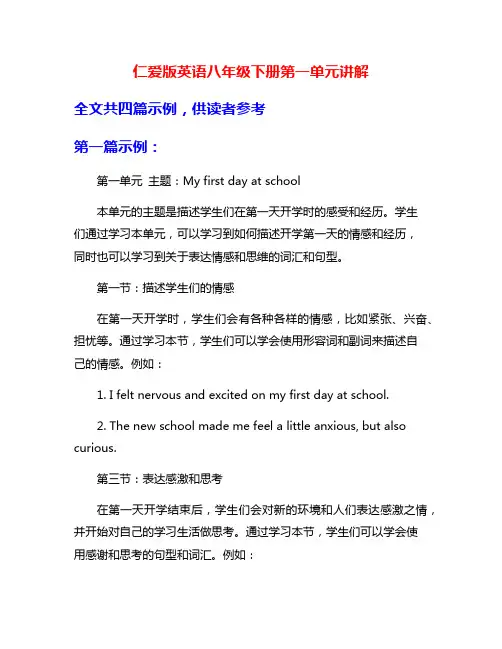
仁爱版英语八年级下册第一单元讲解全文共四篇示例,供读者参考第一篇示例:第一单元主题:My first day at school本单元的主题是描述学生们在第一天开学时的感受和经历。
学生们通过学习本单元,可以学习到如何描述开学第一天的情感和经历,同时也可以学习到关于表达情感和思维的词汇和句型。
第一节:描述学生们的情感在第一天开学时,学生们会有各种各样的情感,比如紧张、兴奋、担忧等。
通过学习本节,学生们可以学会使用形容词和副词来描述自己的情感。
例如:1. I felt nervous and excited on my first day at school.2. The new school made me feel a little anxious, but also curious.第三节:表达感激和思考在第一天开学结束后,学生们会对新的环境和人们表达感激之情,并开始对自己的学习生活做思考。
通过学习本节,学生们可以学会使用感谢和思考的句型和词汇。
例如:通过学习本单元,学生们可以不仅能够更好地描述自己的情感和经历,还能够学会如何感激和思考。
这些能力不仅在学习中有帮助,也能够在日常生活中帮助学生们更好地表达自己的思想和情感。
希望学生们能够认真学习本单元的内容,充分运用所学知识,提高自己的英语水平。
第二篇示例:第一单元主题Unit 1 My New Teachers本单元主要内容是对新老师进行介绍,学习了解新老师的姓名、国籍、兴趣爱好等信息,打破陌生感。
学会用英文表达自己的节前感受,讨论一下新老师和以往老师的不同之处,努力适应新校园环境,培养积极向上的态度。
1.讲解新单词:New Teachers:新老师China:n.中国English:n.英语French:n.法国Canada:n.加拿大Japanese:n.日本2.掌握新知识:(1)Whats,What are,What is 和How many 的用法如:What is your brother?(你的哥哥是干什么的?)(2)反义疑问句的构成及肯定和否定形式如:Kate is a Chinese teacher,isnt she?(凯特是中国老师,不是吗?)3.运用所学知识:4.单元话题:5.情景对话:Scene 1:At the beginning of the termB:His name is Mr. Wang. He is from China.A:Let’s welcome him!Scene 2:Between the classesA:Really?I heard that she likes reading very much.6.小结:通过本单元的学习,学生可以更好地了解新老师,增进与新老师的交流,培养良好的师生关系。
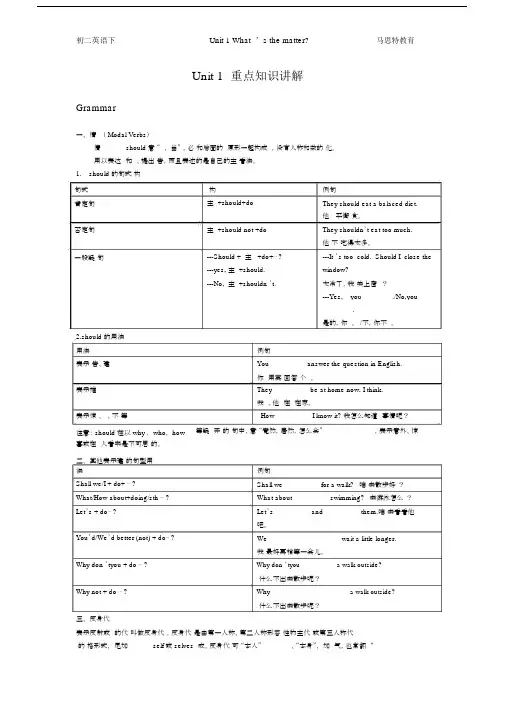
初二英语下Unit 1 What ’s the matter?马思特教育Unit 1 重点知识讲解Grammar一、情( Modal Verbs)情should 意“ ,当” ,必和后面的原形一起构成,没有人称和数的化。
用以表达和、提出告,而且表述的是自己的主看法。
1.should 的句式构句式构例句肯定句主 +should+do They should eat a balaced diet.他平衡食。
否定句主 +should not +do They shouldn’t eat too much.他不吃得太多。
一般疑句---Should + 主 +do+⋯ ? ---It ’s too cold. Should I close the---yes, 主 +should. window?---No, 主 +shouldn ’t. 太冷了,我关上窗?---Yes, you ______./No,you________.是的,你。
/不,你不。
2.should 的用法用法例句表示告、建You _________ answer the question in English.你用英回答个。
表示推表示惊、、不等注意: should 在以 why , who, how 喜或在人看来是不可思的。
二、其他表示建的句型用法Shall we/I + do+ ⋯ ?What/How about+doing/sth ⋯ ? Let’s + do⋯ ?You’d/We’d better (not) + do⋯ ?They _________ be at home now, I think.我,他在在家。
How _________ I know it? 我怎么知道事情呢?等疑开的句中,意“竟然,居然,怎么会”,表示意外、惊例句Shall we _________ for a walk?咱去散步好?What about _________ swimming?去游泳怎么?Let’s _________ and _________ them.咱去看看他吧。
Unit 1重点知识讲解Grammar一、情态动词(Modal Verbs)情态动词should意为“应该,应当”,必须和后面的动词原形一起构成谓语,没有人称和数的变化。
用以表达职责和义务、提出劝告,而且表述的是自己的主观看法。
喜或在说话人看来是不可思议的。
表示反射或强调的代词叫做反身代词。
反身代词是由第一人称、第二人称形容词性物主代词或第三人称代词的宾格形式,词尾加self或selves组成。
反身代词可译“本人”、“本身”,为加强语气,也常翻译为“亲自”、“自己”。
不定人称代词one-----oneself.单词的用法Section A1.What’s the matter?怎么了?该句常用询问某人患了何种疾病或遇到了什么麻烦,其后用with引出对象。
1). What’s the matter with sb.?=what’s wrong with sb.?=what’s the trouble/problem with sb.?=what’s one’s trouble/problem?e.g. What’s the matter with Tom?=what’s _________ with Tom?=What’s the _________ with Tom?=What’s Tom’s _________?2). matter, 名词,“问题,事情”e.g. We have important _________(matter) to discuss.我们有些重要的问题要讨论。
3). 动词,“要紧,关系重大”e.g. It dosen’t _________ that you came late.2.I have a cold.我感冒了。
1).have/get/catch a cold “感冒,着凉”The old man _________ a cold yesterday.那位老人昨天感冒了。
1. What’s the matter (with you)? 怎么了?出什么事了?2. I had a cold.我感冒了。
have a stomachache胃疼,肚子疼have a toothache牙疼have a headache头疼3. 身体部位+ache(疼痛)构成新的复合词stomach+ache=stomachache head+ache=headache tooth+ache=toothache back+ache=backache后背痛5. enough【形容、副词】足够的/地good enough足够好,6. lie down躺下,lie 躺,躺着,过去式lay;lie说谎,过去式lied7. maybe “或许”,常用于句首,表示可能性,后加句子。
Maybe you are right.may be,是情态动词+be的结构,意为“可能,也许”,后加名词、代词或形容词。
He may be angry.8. sound like+名词代词和从句:It sounds like you don’t know the truth. It sounds like a good idea.sound+形容词,“听起来,好像”,The music sounds nice.9. need 需要,实义动词need+名词,需要某物;need to do sth.需要做某事,主语通常是人,表示人主动的动作:You need to listen carefully during class.need doing sth.主语通常是物,表示被动的动作:Your dirty clothes need washing.10. get off (the bus) 下(公交车)get on 上车11. agree 同意,赞同;同意做某事12. trouble问题,麻烦;have trouble (in) doing sth. 。
13. right away=right now=at once,意为。
14. advice [不可数名词]劝告,建议,向…征求意见give sb. advice on sth.就某事给某人建议;advise [动词] advise sb. to do sth. advise sb. doing sth .15. exercise 动词意为锻炼16. hurt 及物动词,使……疼痛,……受伤,不及物动词,……(部位)疼。
His leg hurt badly.17. clean 【动词】清洁cleaner意为清洁工18. hit (用手或器具)打;击打The boy hit the dog with a stone.hit sb. on the head/ nose/ back打某人的头、鼻子、后背,on用在所打较硬的部位;hit sb. in the face/ eye/ stomach 打某人的脸、眼睛、肚子,in用在所打较软的部位。
19. be used to sth./ doing sth.习惯于、适应了……、做某事,强调状态;His grandpa was used to country life.Mary is not used to getting up early in the morning.20. free [形容词]空闲的free time;免费的the drink is for free;自由的I want to become a free bird. free【动词】使……解脱,得到自由He could not free his arm.21. run out用完,用尽When his water run out, he knew that he would have to do something to save his own life. 物sth. tun out. 某物用尽了。
人sb. run out of物sth..人用尽了某物。
He run out of all his money last night.22. risk (sb.) to do sth. 冒险去做某事take a risk=take risks 冒险23. the importance of (doing) sth.(做)某事的重要性We students should know the importance of (learning) English. importance n. 重要(性),important adj.重要的,unimportant adj.不重要的24. decision 【名词】决定;抉择;25. be in the control of …掌管,管理The headmaster is in the control of this new school.be out of control无法控制,无法管理be under control被控制住,在控制之中26. mind意为意见;介意27. give up (doing) sth. 放弃(做)某事,give up (playing) computer games;give up后可接名词、代词和动词ing形式,也可不接,如Never give up easily.二、重要短语1. have a cold 感冒8. think about…思考2. have a stomachache 肚子痛9. be interested in sth.对某事感兴趣3. see sb. do sth. 看见某人做某事10. lose one’s life丧生4. shout for help 呼救11. save one’s life挽救某人生命5. expect (sb.) to do sth.期待某人做某事12. take a risk=take risks冒险6. to one’s surprise使某人惊讶的是13. cut off切断7. thanks to …幸亏14. keep on doing sth.继续做某事三、重点语法反身代词【用法】1. 可用作宾语,指的是宾语和主语表示同一个或同一些的人或事物。
如:Maria bought herself a scarf. We must look after ourselves very well.2. 可用作表语,指的是表语和主语表示同一个或同一些人或事物。
如:She isn’t quite herself today.3. 可用作主语或宾语的同位语,常用来加强语气。
如:She herself will fly to London tomorrow. I met the writer himself last week.4. 用在某些固定短语当中。
如:look after oneself / take care of oneself 照顾自己teach oneself sth./ learn sth. by oneself自学enjoy oneself 玩得高兴,过得愉快help oneself to sth 请自用……(随便吃/喝些……). hurt oneself摔伤自己say to oneself自言自语leave sb. by oneself把某人单独留下buy oneself sth.给自己买……东西introduce oneself 介绍……自己【提醒】1. 反身代词不能单独做主语,但可以做主语的同位语,起强调作用。
如:我自己能完成作业。
(误)Myself can finish my homework. (正) I myself can finish my homework. / I can finish my homework myself.2. 反身代词表示“某人自己”不能表示“某人的东西”,因为它没有所有格的形式。
表达“某人自己的(东西)”时,须要用one’s own.如:我用我自己的蜡笔画画。
(误)I’m drawing with myself crayons. (正) I’m drawing with my own crayons.【练习】1. My classmate, Li Ming, made a card for _________ just now.2. Bad luck! I cut _________ with a knife yesterday.3. They tell us they can look after_________ very well.4. My cat can find food by_________ .5. Help __________to some beef, boys.(help oneself to:尽情享受)6. Jenny enjoyed_________ in the park yesterday afternoon.7. We can finish our homework by_________ .8. The blind girl lost_________ in the beautiful music.9. Xiao Hui, can you introduce _________ to us ?10. Bill wants to teach_________ French from now on.一词汇分类:(Vocabulary) 1. 表示身体各部位的词有:head 头neck 颈部back 后背leg 腿arm 手hand 手foot 脚nose 鼻子eye 眼睛ear 耳朵mouth 嘴tooth 牙齿stomach 胃(注意foot的复数形式为feet,tooth的复数形式为teeth)2. 表示生病或不适的名词有:a cold感冒headache头痛toothache牙痛stomachache胃痛fever 发烧backache后背痛sore throat 咽部疼痛3. 表示身体感觉的形容词有:tired 累的thirsty 口渴的hungry 饿的stressed out 紧张的,有压力的 4. 医生dentist 牙医二目标语言(主要句型)(Target Language)1. What‟s the matter ? 怎么了?2. I have a headache . 我头疼。
3. You should go to bed . 你应该上床了。
4. That‟s a good idea . 那倒是个好主意。